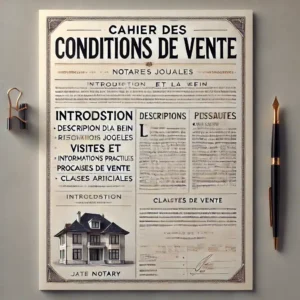The schedule of conditions of sale is an essential document for ensuring that the foreclosure procedure is properly conducted. It is carefully drafted and filed to meet a variety of objectives. Analysis.
Definition of the terms and conditions of sale
The cahier des conditions de vente can be considered as a draft title de vente. It is a document that contains all the information relating to the procedure and the sale. The enforcement judge will convert it into a bill of sale at the time of the auction.
In addition, prospective buyers will be able to consult it before the sale. At this stage, it will play the role of a sales agreement, providing information prior to the purchase.
Filing the book at the court registry
The procedures for filing the conditions of sale are described in article R. 322-10, paragraph 1, of the French Code of Civil Enforcement Procedures:
"No later than the fifth working day following the summons issued to the distrainee debtor, the pursuing creditor deposits at the registry of the execution judge a schedule of conditions of sale containing a description of the property and the terms of the sale. A copy of the summons issued to the debtor and a certified mortgage statement as at the date of publication of the summons to pay in lieu of seizure are attached.
The terms and conditions of sale must be filed with the Registry of Auctions. The pursuing creditor must make this filing no later than the 5th working day following the summons. This deadline must be met in order for the summons to lapse (article R. 311-11 of the French Code of Civil Enforcement Procedures). The deposit must be accompanied by :
- The building description report, which must include the surface area certificate.
- A copy of the writ of summons issued to the debtor with its exhibits.
- Status of publication of the summons to pay in lieu of seizure. We have seen that the publication of a document is only validated after a wait of several months. The production of a real estate form containing the certificate of deposit certifies that publication is in progress. For this reason, the pursuing creditor orders a real estate listing when it publishes the command.
The clerk's office will provide the lawyer with an acknowledgement of filing of the conditions of sale.
The registry may request other documents at the same time. This applies in particular to the town planning certificate. The registry will have to notify the holders of the right of pre-emption before the sale takes place. The identity of the holders of this right can be found in the town planning certificate.
Diagram of procedural deadlines

The content
The specification will be constructed like a contract, with special conditions and general conditions. Except that in this case the terminology used is that of special provisions and general provisions.
It's not just a quirk: unlike a contract that stipulates, the law provides. Consequently, the terms and conditions of sale, which have a legal origin, contain specific and general provisions. This highly technical subject is analysed in the introduction to our report on the seizure of immovable property.
Special provisions
The pursuing creditor's lawyer must comply with two requirements when drawing up the specifications. Firstly, he must comply with the requirements of the law. Secondly, he must guarantee the quality of the sale by following a commercial logic. The specifications are communicated to prospective buyers before the sale takes place.
Mandatory information
The contents of the book are detailed in article R. 322-10, paragraph 2, of the Code of Civil Enforcement Procedures. The text requires the lawyer to mention :
- The writ of execution on which proceedings are based.
- Statement of amounts due.
- The summons to pay and its publication.
- La designation of the propertythe origin of ownership, easements, current leases, and descriptive minutes.
- The conditions of sale and the reserve price.
- The identity of the escrow agent who will receive the sale price.
The content of the terms and conditions of sale is stipulated on pain of nullity. Invalidity will only be declared if the debtor can justify a grievance (article 114 of the Code of Civil Procedure).
Mention of the publication of the order implies referring to the provisional archiving references mentioned in the certificate of deposit:

Recommended information
The pursuing creditor attaches to the schedule of conditions of sale all documents likely to be of interest to potential buyers. The book will be circulated to prospective buyers before the sale, along with the documents.
It is generally attached to :
- The property diagnostics file.
- Any lease contract.
- Planning information.
- The planning certificate.
- The cadastral matrix.
- In the case of co-ownership: the pre-dated statement, the co-ownership regulations, the maintenance booklet, etc.
All of these elements will give the bidders a clearer picture of the property. This will improve the legal certainty of the transaction, enabling it to be sold at a better price.
The terms and conditions of sale may also provide for the debtor to remain in the premises:
"Unless the terms and conditions of sale provide for the distrainee debtor to remain on the premises, the successful bidder may enforce the eviction order that he has against the distrainee and any of his occupants who do not have any rights enforceable against him from the time the price is paid or deposited and the taxed costs are paid. (article R. 322-64 of the French Code of Civil Enforcement Procedures).
General provisions
The general provisions are drafted by the Conseil national des barreaux. They can be found in Appendix 1 of the National Rules of Procedure for the Legal Profession. Article 12.1 of these rules requires lawyers to use them.
Naturally, the Conseil national des barreaux does not have the power to create the law. The general provisions it has drafted therefore comply with the provisions of the Code of Civil Enforcement Procedures. The CNB has essentially sought to summarise the rights and obligations of purchasers in order to provide them with the best possible information.
Adding new content
As the procedure evolves, new documents may need to be appended to the booklet.
The most common example is the technical diagnostic file. These are drawn up early in the procedure because they enable the creditor to set the asking price. However, some diagnostics are valid for 6 months. If the sale does not take place within 6 months of the file being drawn up, these diagnostics will have to be updated.
Under the old property seizure procedure, the lawyer could file a Dire au cahier des conditions de vente. This document made it possible to attach new documents. These provisions were not renewed in the reform introduced by the Order of 21 April 2006.
However, the practice has endured because it meets a very real need. In the absence of a legal framework, however, it has evolved according to local traditions. As a result, it is sometimes referred to as Dire au cahier, sometimes as additif au cahier.
More rarely, the enforcement judge will require additional submissions to be filed. These submissions will be referred to in the auction judgement. These submissions will be appended to the sales document (title de vente) by way of res judicata.
Advertising
The terms and conditions of sale are central to the marketing of the property.
It contains all the information relating to the sale, in the same way as a compromis or promesse de vente.
The text provides that it may be consulted at the registry of the enforcement judge and at the office of the pursuing creditor's lawyer:
"It may be consulted at the registry of the enforcement judge or at the office of the pursuing creditor's lawyer. (article R. 322-11, paragraph 2, of the Code of Civil Enforcement Procedures)
The practice of consulting the book at the court registry remains. On the other hand, it is now obsolete to consult it at the office of the pursuing creditor's lawyer. The latter will generally make it available to the public on its website.
The Conseil national des barreaux has also created a dedicated website that lawyers use a lot.
The challenge
Any interested party may challenge the contents of the booklet:
"Subject to the provisions of article L. 322-6 relating to the amount of the reserve price, the stipulations of the sales conditions book may be contested by any interested party. (article R. 322-11, paragraph 3, of the Code of Civil Enforcement Procedures)
In practice, it will be in the debtor's interest to contest any information in the schedule that is likely to adversely affect the quality of the sale. It is in the debtor's interest to sell the property at the best possible price.
However, such a challenge will require the presence of a lawyer. In fact, all disputes must be lodged in the form of legal submissions.




